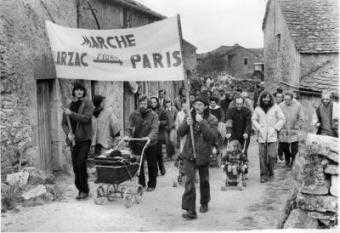Land for the people!
Article in The Broken Rifle No 91, April 2012 on Land-grabbing and militarism
Howard Clark
From the men of property the order came:
They sent the hired men and troopers to wipe out the Diggers' claim.
"Tear down their cottages. Destroy their corn!"
They were dispersed but still the vision carries on.
- Lines from Leon Rosselson's song celebrating the Diggers and their struggle for land in 17th century England
Throughout history, militarism has been associated with the unjust appropriation of land and displacement of the local population. And this is still going on today whether we are referring to military facilities - huge bases now under construction, a variety of testing or training facilities - or to the military enforcers (state or private) of the globalized phenomenon known as "land-grab" in the name of monocultivation, biofuels or resource extraction.
Land is often seen as the foundation of life, and land movements can somehow evoke something deep in us. Perhaps this connection has been recognised more by fascists and nationalists than by urban leftists, but it is also a utopian impulse in anarchist and nonviolent traditions from the Diggers' "common treasury for all", through Kropotkin and Gandhi, to the slogan Tierra y Libertad / Land and Freedom! Indeed, in every continent, among tribal peoples and peasants, we find a different relationship to the land - and indeed to the earth - than the attitudes of domination, exploitation and extraction that underlie so much destruction.
For me, campaigns that combine attachment to land with opposition to war and militarism have always carried a special appeal. I think now of some of the campaigns mentioned in this Broken Rifle, and particularly of the current campaign in Jeju island, South Korea, in which some friends of WRI have been arrested. One of the most inspiring struggles in Europe in the 1970s was the Larzac campaign in France in the 1970s to stop the expansion of a firing range. A campaign that saw farmers taking their sheep to demonstrate with the Eiffel Tower as their backdrop. A campaign that used a wide repertoire of tactics, including war tax resistance and the creation of a land trust in which thousands of people bought their tiny square of the Larzac plateau. A constructive campaign in which people showed alternative uses for the Larzac, setting up a nonviolence training centre, experimenting with renewable energy, and promoting other small cooperative economic projects.
I think too of campaigns in concert with indigenous peoples, especially against nuclear testing or other parts of the nuclear chain, such as uranium mining. This is real protection of heritage - at the local level and at the global level in opposing the nuclear threat.
Historically, war resisters themselves have often looked to forming communities on the land where they can live according to their own values. Today's communities for the peace movement in Colombia have gone much further. Some are declarations by tribes or municipalities of their rejection of arms - be they of the state, the paramilitaries or the guerrilla - but others are communities of several hundred previously displaced people, determined to live in peace, organising themselves in a participatory way, and practising ecological agriculture without conceding to monocultivation. When the former Uribe government insisted on placing a police station, violating the principles of the first Peace Community, San José de Apartadó, members of the community dismantled their homes and collective facilities and rebuilt them away elsewhere.
I am writing shortly after this year's Palestinian day of the land, where Israeli troops killed one protester and injured more than 120 others. Since 1976 this has been a day of protest against the continuing confiscation of Palestinian lands, a central issue in the oppression of Palestinians. It is worth noting that campaigns for the land have not only seen some of the most powerful Palestinian nonviolent actions, but also actions in which Israelis are more likely to take part. Some of the many local struggles against the Separation Wall - a monstrous barrier which confiscates yet more Palestinian land, isolates Palestinian communities one from another and cuts them off from essential resources - can be seen as land struggles. Also some of the most constructive actions that have taken place since the 1960s - such as when groups, often a combination of Palestinians and Israelis have attempted to reclaim the land and its fruits by planting olive trees or trying to harvest olives.
Finally, land remains central to the global social conflict which fuels so many local or national conflicts. Although urban dwellers globally now outnumber rural dwellers for the first time, 75% of the world's poor still live in rural areas. Their access to land is fundamental, especially for the millions of women subsistence farmers. In an age of globalised land-grab, venerable concepts such as "the commons" take on a new relevance for those whose livelihoods are under threat and who face displacement. But more than this, as the groups connected with Via Campesina and other rural networks have emphasised, the issue is not just food security - but food sovereignty: "the right to healthy and culturally appropriate food produced through ecologically sound and sustainable methods, and their right to define their own food and agriculture systems". Against the interests of corporate profit, of supporting non-viable levels of consumption and greed, of seeing land in terms of industrial modes of exploitation and extraction, War Resisters' International stands with those who nonviolently resist and who strive to demonstrate what the world needs.
This earth divided we shall make whole
So it will be a common treasury for all.

Add new comment